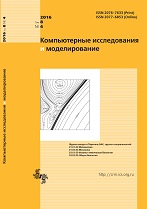|
This article is cited in 12 scientific papers (total in 12 papers)
ANALYSIS AND MODELING OF COMPLEX LIVING SYSTEMS
Regarding the dynamics of cosymmetric predator - prey systems
A. V. Epifanov, V. G. Tsybulin
Southern Federal University,
Bolshaya Sadovaya st. 105/42, Rostov-on-Don, 344006, Russia
Abstract:
To study nonlinear effects of biological species interactions numerical-analytical approach is being developed. The approach is based on the cosymmetry theory accounting for the phenomenon of the emergence of a continuous family of solutions to differential equations where each solution can be obtained from the appropriate initial state. In problems of mathematical ecology the onset of cosymmetry is usually connected with a number of relationships between the parameters of the system. When the relationships collapse families vanish, we get a finite number of isolated solutions instead of a continuum of solutions and transient process can belong-term, dynamics taking place in a neighborhood of a family that has vanished due to cosymmetry collapse.
We consider a model for spatiotemporal competition of predators or prey with an account for directed migration, Holling type II functional response and nonlinear prey growth function permitting Alley effect. We found out the conditions on system parameters under which there is linear with respect to population densities cosymmetry. It is demonstrated that cosymmetry exists for any resource function in case of heterogeneous habitat.Numerical experiment in MATLAB is applied to compute steady states and oscillatory regimes in case of spatial heterogeneity.
The dynamics of three population interactions (two predators and a prey, two prey and a predator) are considered. The onset of families of stationary distributions and limit cycle branching out of equlibria of a family that lose stability are investigated in case of homogeneous habitat. The study of the system for two prey and a predator gave a wonderful result of species coexistence. We have found out parameter regions where three families of stable solutions can be realized: coexistence of two prey in absence of a predator, stationary and oscillatory distributions of three coexisting species. Cosymmetry collapse is analyzed and long-term transient dynamics leading to solutions with the exclusion of one of prey or extinction of a predator is established in the numerical experiment.
Keywords:
mathematical ecology, cosymmetry theory, competitor coexistence, predator – prey, Holling functional response, Alley effect.
Received: 22.05.2017
Revised: 21.08.2017
Accepted: 20.09.2017
Citation:
A. V. Epifanov, V. G. Tsybulin, “Regarding the dynamics of cosymmetric predator - prey systems”, Computer Research and Modeling, 9:5 (2017), 799–813
Linking options:
https://www.mathnet.ru/eng/crm100 https://www.mathnet.ru/eng/crm/v9/i5/p799
|

| Statistics & downloads: |
| Abstract page: | 533 | | Full-text PDF : | 308 | | References: | 59 |
|




 Contact us:
Contact us: Terms of Use
Terms of Use
 Registration to the website
Registration to the website Logotypes
Logotypes









 Citation in format
Citation in format 